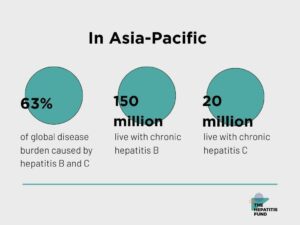In a world grappling with a multitude of pressing challenges and crises, the case for investing in viral hepatitis elimination might seem overshadowed by more immediate emergencies. Disasters, pandemics, economic upheavals, and geopolitical tensions capture the headlines and demand our immediate attention. In this landscape, it’s easy to overlook viral hepatitis, which afflicts millions of people far from the spotlight of mainstream discourse.
But viral hepatitis is an emergency, too. It’s an emergency that affects over 350 million people worldwide and claims the lives of more than one million people per year. This translates into a person losing their life to an entirely preventable disease every 30 seconds. Sadly, these figures are predicted to grow as hepatitis is the only communicable disease where mortality is increasing. Despite its staggering toll, viral hepatitis struggles to secure the resources, attention, and global solidarity that other crises receive.
The good news is that we have highly effective prevention and treatment tools at our disposal: childhood vaccination for hepatitis B can prevent 95% of infections, and new drugs can cure more than 90% of people with chronic hepatitis C infection. Additionally, treatment can reverse liver scarring and the risk of cancer. So, what are we missing to turn the tide and make viral hepatitis a thing of the past?
We miss investments, and we miss political will. The lack of awareness of the epidemic’s threat has led so far to lukewarm political and philanthropic responses and negligible global and national investments compared to other infectious diseases such as malaria or tuberculosis.
Initiated through a collaborative endeavour led by the United States CDC, the World Health Organization, and the ZeShan Foundation, The Hepatitis Fund, based in Geneva, is the world’s first philanthropic platform dedicated exclusively to the mission of ending viral hepatitis. We examine the global hepatitis landscape and direct funding to programmes that can achieve the highest impact towards hepatitis elimination. In doing so, we provide the spark that stakeholders on the ground need to set transformative efforts in motion.
 The burden of hepatitis in Asia
The burden of hepatitis in Asia
Viral hepatitis has a devastating impact on Asia: As of 2019, an estimated 116 million people in the WHO Western Pacific Region were living with hepatitis B and 10 million with hepatitis C. In the WHO South-East Asia Region, an estimated 39 million people were living with hepatitis B and 10 million with hepatitis C.
Asia is the region that experiences the majority of the global disease burden caused by chronic hepatitis B and hepatitis C, with 63% of viral hepatitis-related diseases globally occurring in the Asia Pacific.
Figures show a high prevalence of hepatitis B, particularly in countries like China, Mongolia, Vietnam, and the Philippines, where around one in 10 people have chronic hepatitis B. In Indonesia, 19 million people are infected with hepatitis B virus. Countries like India and China have high hepatitis C prevalence rates. It goes without saying that such a heavy prevalence has a profound disruptive effect on society in the Asian region. On top of causing a tragic loss of life, viral hepatitis poses a huge societal and financial burden and drives inequality.
Access to prevention, screening and treatment for hepatitis B and C remain a challenge in many Asian countries due to cost and healthcare infrastructure limitations. For example, in the Western Pacific Region, only 18% of people with hepatitis B are diagnosed. Furthermore, vertical transmission (from mother to child) of hepatitis B is a major concern: each year, in the same region, over 180,000 new-born babies are newly infected by hepatitis B through vertical transmission (compared with 1,400 by HIV).
The impact of The Hepatitis Fund in Asia
During our first round of grants, we supported two programmes in Asia: Accelerating Diagnosis in Vietnam, implemented by PATH in collaboration with the Ministry of Health’s Vietnam Administration of Medical Services, and a programme in Pakistan aimed to develop, pilot, and evaluate integrated hepatitis C care-package at 48 rural health centres in high burden districts of Punjab. The programme was implemented by the Association for Social Development. In partnership with the City of Geneva, we are also funding a three-year programme in Vietnam focused on the elimination of vertical transmission of hepatitis B. The first two programmes have ended, and both brought positive results that went beyond the expected outcomes.
These programmes are examples of how The Hepatitis Fund invests in catalytic initiatives to reshape local ecosystems. The strategic investments are selected to demonstrate how best to introduce or enhance interventions that overcome barriers hindering viral hepatitis response efforts.
Viral hepatitis is one of the few SDGs that can be achieved by 2030, but we need to act now, also because the cost of inaction would be too high: Without a robust increase in investments, deaths due to hepatitis will outnumber the total deaths due to HIV, TB and malaria combined by 2040.
We plan to open a new call for proposals by the first half of 2024, and we have identified key countries where catalytic investment would either kick-start implementation of a national plan or significantly accelerate it, where political commitment exists, and where early action has already occurred. In Asia, these countries will have priority, due to their high disease burden: Vietnam, Indonesia, Cambodia, Philippines, and Pakistan.
Addressing viral hepatitis can save countless lives and pave the way for a more equitable world. We cannot afford to miss the opportunity to build a healthier future. Reach out to The Hepatitis Fund to learn how you can take action to eliminate viral hepatitis from your community, one patient at a time.


















 The burden of hepatitis in Asia
The burden of hepatitis in Asia